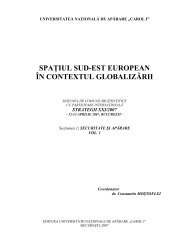PROVOCĂRI LA ADRESA SECURITĂŢII ŞI STRATEGIEI LA ÎNCEPUTUL SECOLULUI XXI
provocări la adresa securităţii şi strategiei la începutul secolului xxi
provocări la adresa securităţii şi strategiei la începutul secolului xxi
You also want an ePaper? Increase the reach of your titles
YUMPU automatically turns print PDFs into web optimized ePapers that Google loves.
contribute to NATO-led operations [27]. The PfP has provided "a unique<br />
instrument for countries who are not seeking membership to contribute to<br />
Euro-Atlantic security without compromising the principles of their foreign<br />
and security policies."<br />
NATO launched the Partnership for Peace [28] for opening a new<br />
chapter in its relations with partner countries in Central and Eastern Europe,<br />
the Caucasus and Central Asia. The basic aim is to stimulate and support<br />
domestic defense reform in partner countries and the creation of modern,<br />
effective and democratically responsible armed forces and other defense<br />
institutions. A key aspect of the Partnership for Peace is building<br />
interoperability, meaning that forces from partner countries are trained to<br />
operate side by side with troops from NATO countries, allowing partner<br />
countries to contribute to NATO-led operations.<br />
In 2002, at the Prague Summit, NATO Heads of State and<br />
Government reaffirmed their commitment to NATO's partnerships. A<br />
number of reforms were introduced to make the Partnership for Peace.<br />
Various steps are currently being taken to also enhance the operational and<br />
decision-making roles of Partners.<br />
A special Political-Military Framework (PMF) allows Partner<br />
involvement in political consultation and decision-making, operational<br />
planning and building forces for NATO-led PfP operations. An Operational<br />
Capabilities Concept (OCC) also helps to assemble multinational forces for<br />
crises.<br />
Following the shocking events of 11 September, 2001 Partnership<br />
provided the framework for the 46 participating nations to respond together<br />
to the threat of terrorism.<br />
The key incentive that animated partner engagement in the<br />
program, that it was the “best path to NATO membership,” is diminished<br />
since the remaining partners are either not interested or not likely to enter<br />
the Alliance for many years.<br />
To retain its relevance and effectiveness, PfP must be transformed,<br />
adequately resourced, and better integrated with bilateral and regional<br />
efforts to address new security challenges [29].<br />
The remaining 20 partners, particularly around the greater Black<br />
Sea, in the Caucasus, and Central Asia, have significantly weaker political,<br />
economic, social, and security and defense institutions and require greater<br />
assistance to bring their personnel and institutions closer to NATO<br />
standards.<br />
To better address the new challenges, the 2002 Summit approved<br />
the Prague Capabilities Commitment (PCC), the new Command Structure,<br />
and the NATO Response Force (NRF). The centerpiece is NRF, with high<br />
tech capabilities for expeditionary missions that would allow NATO’s<br />
European allies to contribute small niche units — for example: police,<br />
engineering, demining, chemical decontamination, alpine, and Special<br />
Forces units — with secure communications, ample readiness, and the<br />
capability of deploying, sustaining, and operating with U.S. forces through<br />
the entire conflict spectrum.<br />
The Prague Summit also endorsed the Military Concept for<br />
Defense Against terrorism that calls for “improved intelligence sharing and<br />
crisis response arrangements [and commitment with partners] and the<br />
Partnership Action Plan Against Terrorism, adopted by the EAPC in<br />
November 2002, partners commit to taking a number of steps to combat<br />
terrorism and share their information and experience. Although the plan has<br />
not yet achieved much, it does establish a framework upon which necessary<br />
functions can be built [30].<br />
Keeping PfP relevant requires focusing on the development of<br />
capabilities to combat terrorism and other transnational threats. New<br />
programs could target sharing more intelligence from interior ministries,<br />
police, and border guards, as well as finance and banking information.<br />
Budgets and functions also need to be re-examined and updated to<br />
support future counter-terrorist operations, including counter-proliferation<br />
efforts and missile defense systems.<br />
One way might be to make NATO exercises in the Caucasus and<br />
Central Asia more flexible and allow non-aligned partners to take a greater<br />
part in their planning, while encouraging their security sector expertise.<br />
The incentives for PfP participation vary widely between Russia,<br />
with no interest in formal membership, and Ukraine, who aspires to join<br />
NATO.<br />
The PfP Trust Fund, which has allocated $4.2 million for<br />
destroying anti-personnel mines in Albania, Ukraine, Moldova and<br />
disposing of missile stockpiles in Georgia, must be expanded. One goal of<br />
PfP Trust Funds is the destruction of anti-personal landmines in Moldova<br />
and Ukraine [31].<br />
The NATO Security Investment Program (NSIP), a much larger<br />
program with an annual budget of over $600 million, covers installations<br />
and facilities dealing with communications and information systems, radar,<br />
military headquarters, airfields, fuel pipelines and storage, harbors, and<br />
navigational aids. NSIP funds now ought to be broader Black Sea region to<br />
augment NATO air, road, and rail support.<br />
NATO's intention to place a special focus on relations with the<br />
states of the Caucasus and Central Asia, including the decision by the<br />
Alliance to appoint one liaison officer for each region [32].<br />
295<br />
296





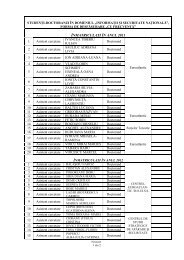
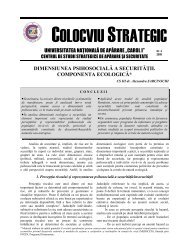
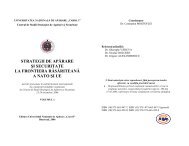
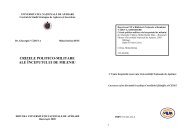
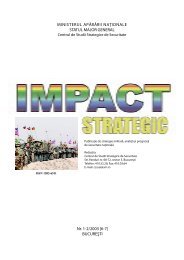


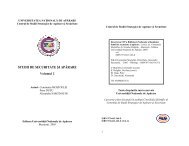

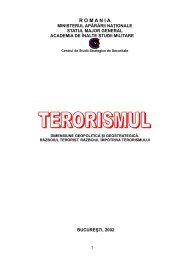

![„CAROL Nr 4 [29]/2008](https://img.yumpu.com/53801719/1/184x260/carol-nr-4-29-2008.jpg?quality=85)
